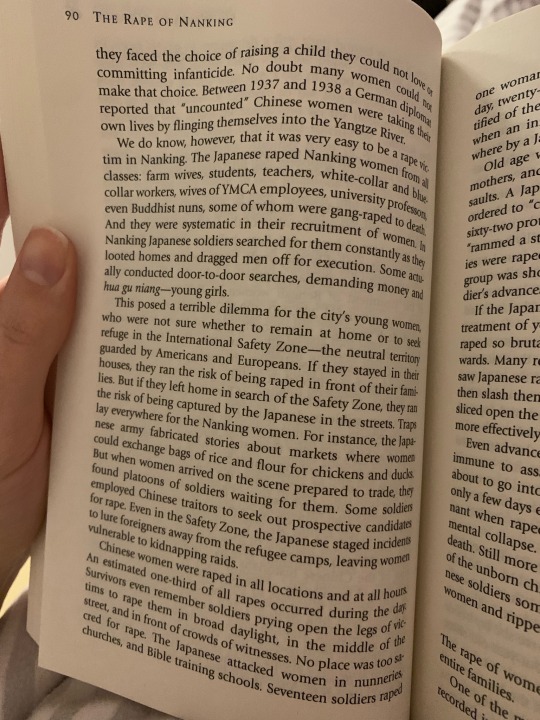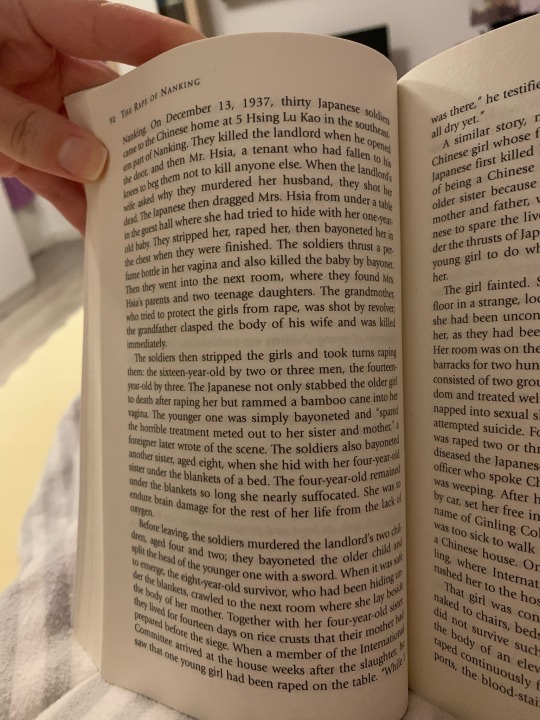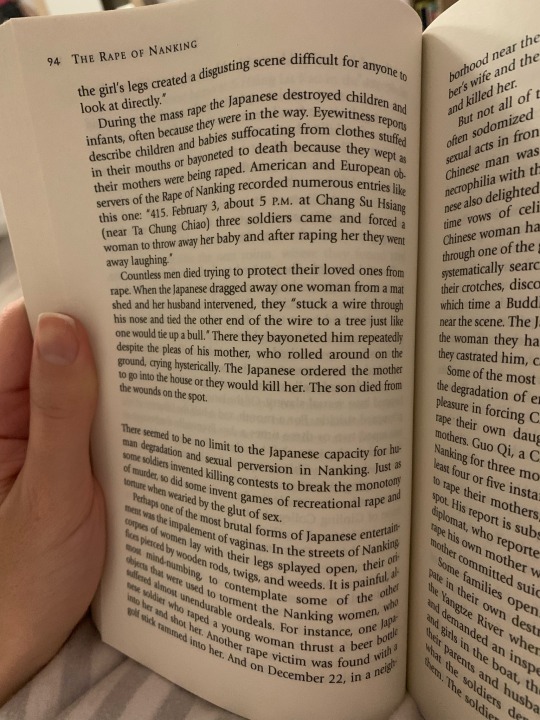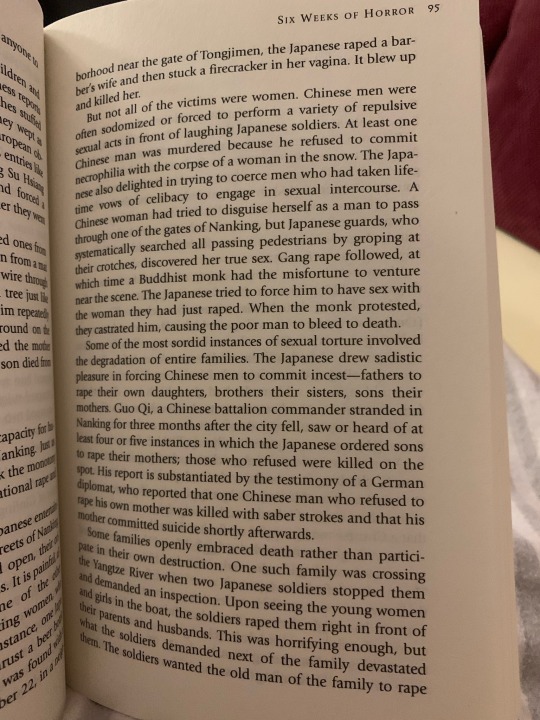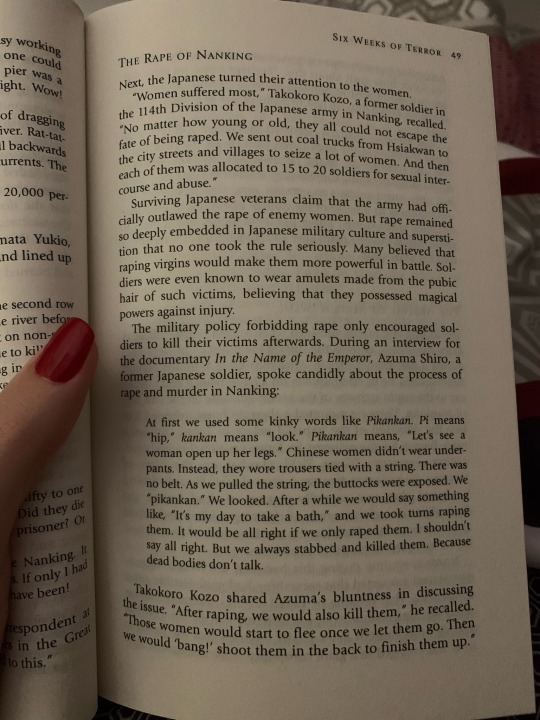#the rape of nanking
Text
Okay, so I'm rereading Iris Chang's The Rape of Nanking and honestly I should have skipped the forward.
At one point the Forward (written by William Kirby) has this line:
"We may never know precisely what motivated Japanese commanders and troops to such bestial behavior"
But then if you read the Introduction by Chang, she mentions briefly the "master-race" mentality that was the driving force and the first part of the book goes into further detail about how deep the propaganda was in the years leading up to World War II.
This line feels out of place in retrospect.
11 notes
·
View notes
Text
Even by the standards of history's most destructive war, the Rape of Nanking represents one of the worst instances of mass extermination, when the Japanese Imperial Army invaded the Chinese city of Nanking and tortured its inhabitants in the most barbaric ways possible. While it is true that in the twentieth century, Hitler killed about 6 million Jews and Stalin more than 40 million Russians, these deaths were brought about over some few years. In the Rape of Nanking, the killings were concentrated within a few weeks.
The death toll of Nanking - one Chinese city alone - exceeds the number of civilian casualties of some European countries for the entire war.
The worst air attacks of the war [WWII] did not exceed the ravages of Nanking. It far exceeded deaths from the American raids on Tokyo, even exceeding the combined death toll of the two atomic blasts at Hiroshima and Nagasaki.
Yet this massacre remains neglected in most of the historical literature published in the United States, and remains virtually unknown to people outside of Asia. Only in Robert Leckie's book, Delivered from Evil: The Saga of World War II, did I find a single paragraph about the massacre: "Nothing the Nazis under Hitler would do to disgrace their own victories could rival the atrocities of Japanese soldiers under General Iwane Matsui."
That the Nanking massacre my parents told me about was not merely folk myth but accurate oral history hit me in December 1994, when I attended a conference sponsored by the Global Alliance for Preserving the History of World War II in Asia, which commemorated the victims of the Nanking atrocities. In the conference hall the organizers had prepared poster-sized photographs of the Rape of Nanking - some of the most gruesome photographs I had ever seen in my life. Even children and infants were tortured and killed.
Though I had heard so much about the Nanking massacre as a child, nothing prepared me for these pictures - stark black-and-white images of decapitated heads, bellies ripped open, and nude women forced by their rapists into various pornographic poses, their faces contorted into unforgettable expressions of agony and shame.
At the time, no one had written a nonfiction book on the Rape of Nanking in English, and there were only two fiction novels that were in the works. Why had nobody else?
I soon had at least part of the answer as to why the massacre had remained relatively untreated in world history. The Rape of Nanking had not penetrated the world consciousness in the same manner as the Holocaust or Hiroshima because the victims themselves had remained silent.
Furthermore, an atmosphere of intimidation in Japan stifled open and scholarly discussion of the Rape of Nanking, further suppressing knowledge of the event. In Japan, to express one's true opinions about the Sino-Japanese War could be - and continues to be - career-threatening and even life-threatening. (In 1990 a gunman shot Motoshima Hitoshi, mayor of Nagasaki, in the chest for saying that Emperor Hirohito bore some responsibility for World War II.)
What baffled and saddened me during the writing of this book was the persistent Japanese refusal to come to terms with its own past. It is not just that Japan has doled out less than 1 percent of the amount that Germany has paid in reparations to its war victims. It is not just that, unlike most Nazis, who, if not incarcerated for their crimes were at least forced from public life, many Japanese war criminals continued to occupy powerful positions in industry and government after the war. And it is not just the fact that while Germans have made repeated apologies to their Holocaust victims, the Japanese have enshrined their war criminals in Tokyo - an act that one American wartime victim of the Japanese has labeled politically equivalent to "erecting a cathedral for Hitler in the middle of Berlin."
Strongly motivating me throughout this long and difficult labor was the stubborn refusal of many prominent Japanese politicians, academics, and industrial leaders to admit, despite overwhelming evidence, that the Nanking massacre had even happened. In contrast to Germany, where it is illegal for teachers to delete the Holocaust from their history curricula, the Japanese have for decades systematically purged references to the Nanking massacre from their textbooks, removed photographs from museums, tampered with original source material, and excised from popular culture any mention of the massacre.
The ugliest aspects of Japanese military behavior during the Sino-Japanese War have indeed been left out of the education of Japanese schoolchildren. But they have also camouflaged the nation's role in initiating the war within the carefully cultivated myth that the Japanese were the victims, not the instigators, of World War II. The horror visited on the Japanese people during the atomic bombings of Hiroshima and Nagasaki helped this myth replace history.
-Iris Chang, The Rape of Nanking
#iris chang#the rape of nanking#book#book quotes#nanking#china#japan#world war ii#history#chinese history#japanese history#war crimes
19 notes
·
View notes
Text
Dark times paralyze most people, but some very few, for reasons most of us will never understand, are able to set aside all caution and do things even they could not imagine themselves doing in ordinary times.
The Rape of Nanking, Iris Chang
2 notes
·
View notes
Text

#nankingmassacre#the rape of nanking#nanjing massacre#19371213#南京大屠杀#南京大屠殺#antiwar#worldpeace#iris chang#minnie vautrin#johnrabe
2 notes
·
View notes
Note
On a scale of one to ten, how much would you recommend the poppy wars? From what I've been able to read here and there, it's inspired/about the opium wars but there are fantastical elements to it, and it sounds cool
On a scale from 1 to 10? Probably about 20.
It's about the opium wars and the Second Sino-Japanese War from a historical perspective, and is very well-research and borrows heavily from factual accounts of the wars, which is why it's described as a military fantasy (see also: The Rape of Nanking by Iris Chang).
The fantastical elements (e.g. the powers of the main characters) are excellently portrayed, as they're not just there to excite– they're metaphors and they bring the plot of China's history to life. It's my favorite high fantasy series.
I would only not recommend TPW trilogy to someone if you're sensitive to its very graphic content which includes, but isn't limited to, detailed depictions of genocide, rape, and torture. I believe @fangruninsimp has a comprehensive list of the trigger warnings.
#the poppy war#tpw#the burning god#the dragon republic#rf kuang#the rape of nanking#book recommendations#fantasy books#ask#anon ask#book recs
24 notes
·
View notes
Text

"The Rape of Nanking: The Forgotten Holocaust of World War II" by Iris Chang
Thank you @booksbecread for the intense, important read. ❤️
#The rape of Nanking#Iris Chang#Whistleblower#War Crimes#Never Again#nonfiction books#world war 2#world war 2 books#ww2#ww2 books#important books#book recommendations#book#books#book review#diverse reads#diverse books#diverse authors
0 notes
Text
Book Review: The R*pe of Nanking by Iris Chang
Wow. This book contains some heavy yet powerful reading. And as heavy as a reading it is, I think it is a necessary read. I had no idea of the atrocities committed in WW2 by the Japanese.
They say those who don't study history are doomed to repeat it. That's why this book is so important. Without learning from the past, we cannot let this part of history fade away. The Germans have made it their mission to teach everyone about. the Holocaust, yet Japan wants their dirty secrets wiped off the face of the earth. I don't blame them. The Japan of the past is different from the Japan of today. But that doesn't mean we should forget what happened. I get they are ashamed of what they did, but the world needs to know what happened.
And thankfully, Chang wrote this book to help ensure this dark time in human history doesn't fade away. I can't imagine what went through Chang's mind when collecting all the research to make this book happen. It saddens me to hear of her passing, and I wonder if studying all this horrible history was a small part of her death. But she should be proud of the work she accomplished in making sure the people who died, as well as the survivors, live on. This is a story that needs to be told, even if it's a hard one to hear.
I personally think they should make (or edit it) to be part of a history textbook. It's well-written and researched. If you are in the right headspace and want to learn more about this forgotten Holocaust, I highly recommend this book.
1 note
·
View note
Text
About to finish reading “The Rape of Nanking” by Iris Chang.
#booktok#book recommendations#books#bookblr#bookish#nanking#the rape of Nanking#Iris chang#world war 2#Japan#China
1 note
·
View note
Text
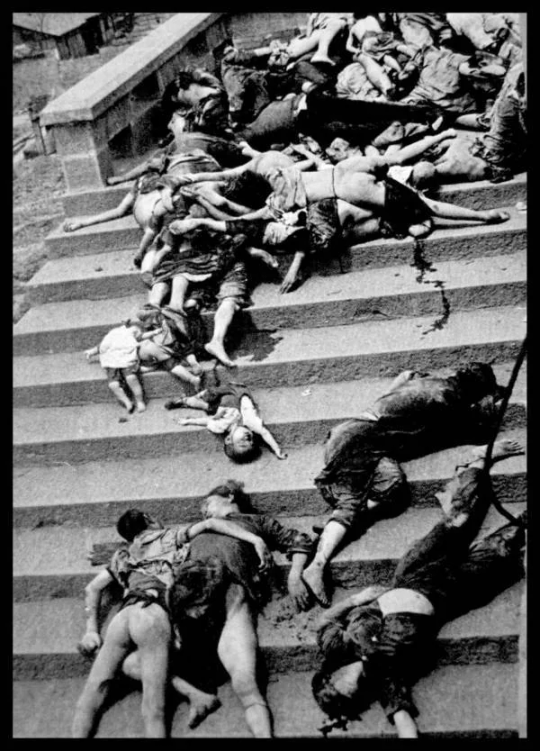
Dead bodies of men, women, and children alike litter the steps of Nanking after the Japanese capture of the city. 1937-1938.
23 notes
·
View notes
Text
Japanese armies invaded China's northern provinces and quickly captured the ancient Chinese capital Peking (now called Beijing), where Pamela Werner was murdered in 1937 [before the Japanese invasion - the case is still unsolved]. In this war, the Japanese enjoyed overwhelming superiority in numbers, training, and weapons.
While fighting was happening in Northern China, the Japanese launched a second front on the city of Shanghai, on the eastern coast of China. They captured Shanghai also in 1937. They were then able to move up the Yangtze River and lay seige to the Nationalist capital Nanking (now called Nanjing).
By the time of Nanking's capture, the Japanese already controlled large sections of China, and war crimes against the Chinese became commonplace.
This all took place during the Sino-Japanese War, in particular, the second Sino-Japanese war between the Republic of China and the Empire of Japan, with the first war having taken place in 1894.
When Nanking fell to the Japanese troops, they immediately slaughtered thousands of Chinese soldiers who had surrendered to them, as well as civilians. For six weeks, life for the Chinese in Nanking became a nightmare. Bands of drunken Japanese soldiers roamed the city, murdering, raping, looting and burning the city at whim. At least twenty thousand Chinese women were raped in Nanking during the first four weeks of the Japanese occupation, and many were afterward mutilated and killed.
**Warning: Disturbing Content**
******************
When the bodies of murdered Chinese turned the gutters and the Yangtze River red with their blood, the Japanese were forced to refine their methods of slaughter in the interest of preventing the spread of disease. Batches of Chinese civilians were sent to slaughter pits, where they were buried alive, hacked to death with swords, used for bayonet practice, or poured with petrol and burned alive. The Japanese even posed with their dead victims - burned corpses, bayoneted babies, headless bodies, and disembowled women. Sons were forced to sodomize their own mothers and then were usually murdered. Unlike the Nazis, who tried to hide or at least obscure the scope of their atrocities on civilians, the Japanese flaunted theirs in full view of horrified foreigners with cameras, most of whom tried futilely to stem the slaughter, even as they recorded it on film.
"The Japanese took souvenir pictures of what they did, particularly to the women. Many were forced into pornographic poses before, after or during mutilation and death," said Iris Chang, the author of bestselling book The Rape of Nanking. "I had to omit the worst pictures from my book because I feared they might cause it to be banned from school libraries. And school libraries are where I want it most to be."
In fact, the ritual gang-rapes perpetuated by the Japanese Army would have only been hearsay if not for the photographs the soldiers themselves took of their crimes to send back home as souvenirs.
Though her grandparents managed to escape just before the Japanese entered Nanking, Chang found herself consumed with documenting the massacre before the last of the survivors passed away. In Nanjing she located 10 survivors, including one who was a pregnant teenager when the city was sacked.
"She actually fought off the Japanese soldiers who tried to rape her," said Chang. "They bayoneted her 37 times. She was photographed afterward at the hospital. She lost the baby, but somehow lived through it. She's obviously a very strong woman."
One woman, who was eight at the time, remembers her father being shot, and she and her mother being raped by soldiers. She still suffers to this day from the brutal attack.
Following the massive destruction of Nanking, China's capital was left in ruin. The Japanese government installed a puppet government headed by General Matsui Iwane (who declared the attack on Nanking) and his lieutenant, Tani Hisao, to rule over Nanking, where they maintained power until the end of World War II, after which both Matsui Iwane and Tani Hisao were tried and convicted of war crimes, leading to their execution. Unfortunately only a few Japanese were tried for their crimes against humanity in Nanking, with Japan refusing to even acknowledge the massacre even happened, as well as most people outside of Asia never having heard of it.
One week after the surrender of Japan on September 2, 1945, General Douglas MacArthur - the Supreme Commander of the Allied Powers - ordered the arrests of Japanese suspects, including General Hideki Tojo. Twenty-eight defendants, mostly Imperial military officers and government officials, were charged. Seven defendants were sentenced to death by hanging and 16 defendants were sentenced to life imprisonment.
The defendants were:
Sadao Araki
Kenji Doihara
Kingoro Hashimoto
Shunroku Hata
Kiichiro Hiranuma
Koki Hirota
Naoki Hoshino
Seishiro Itagaki
Okinori Kaya
Koichi Kido
Heitaro Kimura
Kuniaki Koiso
Matsui Iwane
Jiro Minami
Akira Muto
Osami Nagano
Takasumi Oka
Shumei Okawa
Hiroshi Oshima
Kenryo Sato
Mamoru Shigemitsu
Shigetaro Shimada
Toshio Shiratori
Teiichi Suzuki
Shigenori Togo
Hideki Tojo
Charges were dropped for Shumei Okawa because he was found to be mentally unfit for trial. Two defendants, Yosuke Matsuoka and Osami Nagano, died of natural causes during the trial. Six defendants were sentenced to death by hanging. One defendant, Matsui Iwane, was sentenced to death. On December 23, 1948, the defendants were executed at Sugamo Prison with Allied Council as witnesses. Six defendants were sentenced to life in prison. Koiso, Shiratori, and Umezu died in prison while the other 13 were paroled between 1954 and 1956.
Eleven countries came together to form the International Military Tribunal for the Far East (IMTFE), convened on April 29, 1946 to try the leaders of Japan for joint conspiracy to start and wage war.
*Japanese History*
Before the massacre, Japan had recently been Westernized and modernized - but in weaponry alone - as they themselves were less than a century out of their Samurai past, with each soldier still reeling from the harsh authoritarian regime under which they served. Japan was an extremely isolated country and the general attitude was overwhelmingly nationalistic.
Living in isolationism for hundreds of years, the old world Japan of 1853 had been shocked into modernization by U.S. Navy Commodore Matthew Perry, who - with just four modern steam warships - had entered Tokyo harbour, trained his canon on the Emperor's place, then demanded and received from the Japanese government precisely the trade treaty that American politicians had long required. Japan's highly militaristic Imperial culture spent the next few years importing into their island as much Western weaponry as they could, taking advantage of the new Western technology to revive its Samurai informed ultra-authoritarianism both at home and abroad.
Right before the Japanese captured the Chinese city of Peking, overt hostilities were felt, due to the Marco Polo Bridge incident of 1937, when shots were exchanged between the Chinese and Japanese on Peking's outskirts. Thereupon full-scale hostilities began between the two nations.
There were the Nationalist Chinese and the Communist Chinese. Nationalist Chinese leadership had been holding their forces in reserve for a future struggle with the Communist Chinese, which hindered them in repelling the Japanese. By contrasts, the Communist Chinese, from their base in North Central China, began an increasingly effective guerrilla war against the Japanese troops in Manchuria and North China.
#rape of nanking#the rape of nanking#nanking massacre#nanjing#china#japan#military#army#history#japanese history#chinese history#matsui iwane
3 notes
·
View notes
Text
For everyone who does not believe a leader would kill 15,000 people, I invite you to google
The Parsley Massacre, in which Rafael Trujillo ordered troops to murder as many as 20,000 Haitians.
Augusto Pinochet, whose regime was responsible for the torture and/or murder of over 40,000 people.
The Rape of Nanking, where Japanese forces murdered 200,000 people and tortured more.
The Bodo League Massacre, where South Korean troops killed HUNDREDS OF THOUSANDS of people.
The 15,000 people in Iran are still very much in danger, whether an official sentence was given or not.
#Parsley Massacre#Rafael Trujillo#Haiti#dominican republic#Chile#augusto pinochet#Japan#South Korea#Rape of nanking#Bodo League Massacre#Iran
109 notes
·
View notes
Text
adrienne rich was right it is literally impossible to escape the female body. brb throwing up violently.
#thinking about post-apocolytic movies#and the fact that even if women survive the horrors of the apocalypse#all the lies in store is r*pe and torture#and being used#the exact thing that happens to women in active war zones. the r*pe of nanking. the soviet r*pe of berlin.#literally going to be sick#tw rape
62 notes
·
View notes
Text
The more I learn about it, the more I realize how fucked-up it is that THE date for the start of World War II is 1939.
I mean… it makes sense from the limited perspective that the Second Italian-Ethiopian War and the Second Sino-Japanese War only involved two opposing nations each, and third parties didn’t get involved until the invasion of Poland. But to justify that, it should really be taught to people as “World War II could have started in 1935 or 1937, except nobody gave a shit when Ethiopia and China were invaded so we’re dating it to 1939 instead” and that is… really not as widespread as it should be.
#we actually did watch a documentary on the Rape of Nanking in our 8th grade unit on the Holocaust#but I’ve read a LOT of WWII history since then#and it’s only on reflection that I’ve realized how unusual that was
13 notes
·
View notes
Text
I have now seen someone say that what the RDA and Quaritch did in the first Avatar wasn’t genocide. Shoutout to the Olangi clan, you guys may be gone but I’ll never forget you. 🫡🫡
#KSKSKSKKS literally they got genocided!!!#as someone who focused on genocide and human rights for two years in school#specifically on different genocidal tactics#babes eugenics is a genocidal tactic#i wrote a four page paper on the rape of nanking and the Japanese textbook controversy#the trail of tears is a genocide one that we in american refuse to recognize#and the native americans are def an inspiration for this movie dog#i feel like not calling it a genocide that that’s clearly what it’s supposed to represent is callous#avatar#avatar the way of water#james cameron avatar#i seriously always find the most interesting posts right as I’m getting in bed fuck right off I need to sleep#olangi#norm spellman#melissa og#melissa on avatar (cameron)#melissa is an english major
22 notes
·
View notes



